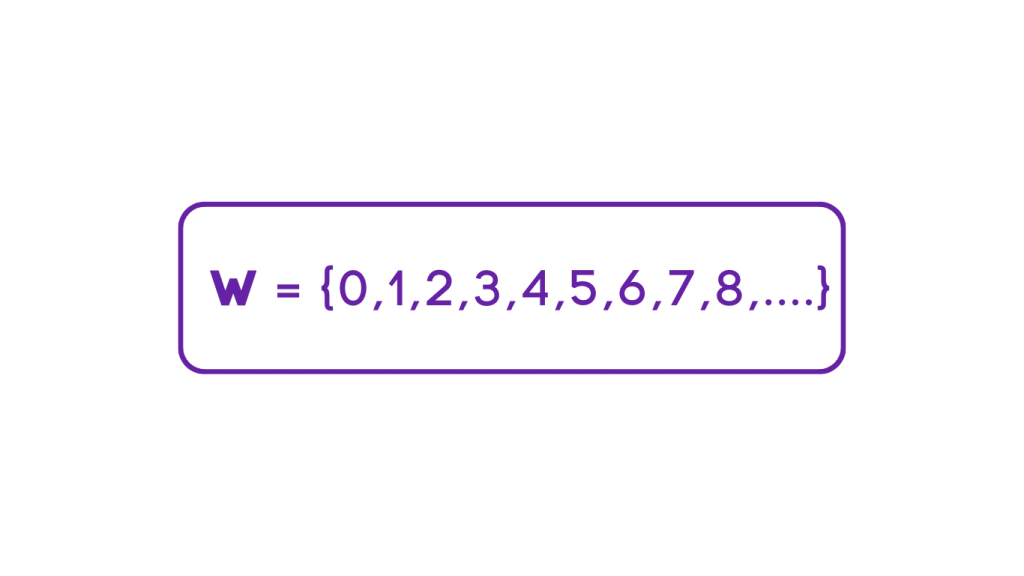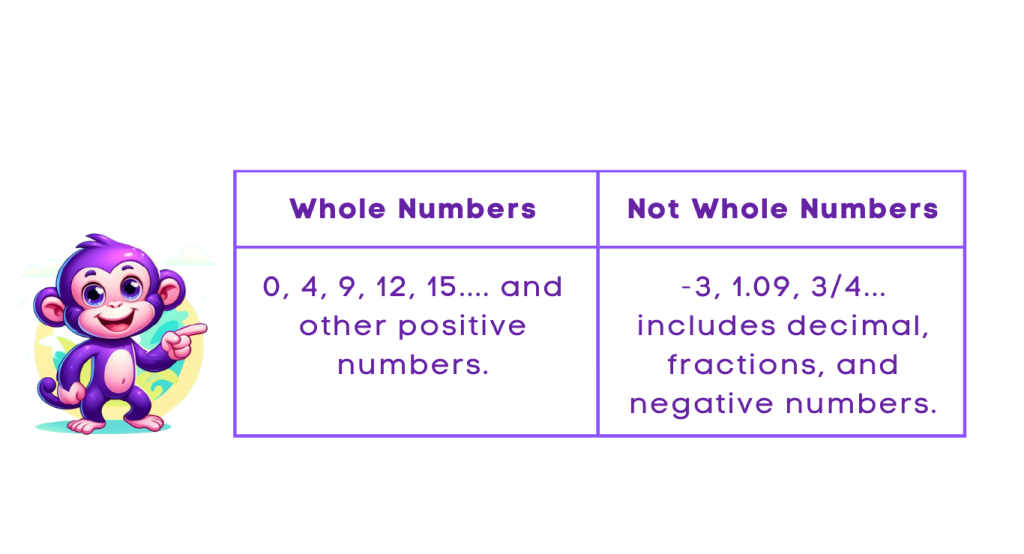Understanding Whole Numbers – Definitions, Properties & Examples
Table of Contents
Introduction
What are Whole Numbers?
Whole numbers are a fundamental part of the number system, encompassing a range of positive integers along with zero. They are used in various mathematical operations and have practical applications in everyday life. Let’s explore its definition and significance in the world of mathematics.
Analogy of Definition
Definition
A whole number is a non-negative integer that includes all the natural numbers (1, 2, 3, …) along with zero (0). In simpler terms, whole numbers are the set of numbers that start from zero and continue infinitely in the positive direction. While integers include both positive and negative numbers, whole numbers are the collection of the positive numbers of the number line. A set of whole numbers is denoted by ‘W’.

Method
Understanding Whole Numbers
Whole numbers can be used in a variety of mathematical operations, including addition, subtraction, multiplication, and division. Whole numbers are all natural number including 0. They are the collection of all positive numbers without fractions, decimals, and negative integers.

Properties of Whole Numbers
The basic mathematical operations of addition, subtraction, multiplication and division, give rise to the four main properties of whole numbers.
Closure Property of Whole Numbers
The product and sum of two whole numbers is always a whole number.
Let us take two numbers 5 and 2
5 + 2 = 7
5 × 2 = 10
Commutative Property of Whole Numbers
The sum and product of any whole number will be the same even if the order of the numbers are interchanged.
Let us take two numbers, 4 and 5
4 + 5 = 5 + 4 = 9
4 × 5 = 5 × 4 = 20
As we can see, the commutative property holds true for both multiplication and addition.
Associative Property of Whole Numbers
The way the whole numbers are grouped during addition and multiplication does not change the result.
For example, let’s take three numbers, 6 , 4 and 8.
(6 + 4 ) + 8 = 18
6 + ( 4 + 8 ) = 18
Thus, (6 + 4) + 8 = 6 + (4 + 8 )
(6 × 4 ) ×8 = 192
6 × ( 4 × 8 ) = 192
Thus, (6 × 4 ) ×8 = 6 × ( 4 × 8 )
Distributive Property of Whole Numbers
If we take three numbers, 2, 4 and 6, as per the distributive property, 2 × (4 +6) = 2 × 4 + 2 × 6 = 20, this holds true for addition as well as subtraction of whole numbers.
Multiplicative Identity
If a whole number is multiplied by 1, its value remains the same. If any whole number is multiplied by 1, the result will be the same number.
Let’s take a number, 5
1 × 5 = 5
5 × 1 = 5
Hence, 1 × 5 = 5 × 1, meaning 1 is the multiplicative identity of whole numbers.
Examples
Using Whole Numbers in Fraction Calculations
Example 1: Dividing a Fraction by a Whole Number
To divide a fraction by a whole number, you can convert the whole number to a fraction with a denominator of 1 and then apply the division operation.
Example: 3/4 ÷ 2 = 3/4 ÷ 2/1 = 3/4 x 1/2 = 3/8
Example 2: Multiplying a Fraction by a Whole Number
To multiply a fraction by a whole number, you can simply multiply the numerator of the fraction by the whole number while keeping the denominator unchanged.
Example: 2/3 x 4 = (2 x 4)/3 = 8/3
Quiz
Tips and Tricks
1. Whole Number Basics
Tips: A whole number includes all the natural numbers along with zero, making it a versatile component of the number system.
2. Understanding Division with Whole Numbers
Tips: When dividing a fraction by a whole number, convert the whole number to a fraction with a denominator of 1 and apply the division operation.
3. Multiplication Techniques with Whole Numbers
Tips: To multiply a fraction by a whole number, simply multiply the numerator of the fraction by the whole number while keeping the denominator unchanged.
4. Whole numbers multiplied by 0
Tips: If a whole number is multiplied by 0, the result wil always be 0. For example, 5 × 0 = 0.
5. Whole number divided by 0
Tips: If a whole number is divided by 0, then it is not defined. For example, 7/0 will be is undefined.
6. Importance of 0 as a Whole Number
Tips: Zero is considered a whole number and plays a crucial role in mathematical operations and real-life applications. It is also the smallest whole number.
Real life application
Counting Items: Counting the number of apples in a basket, the number of books on a shelf, or the number of people in a room are all real-life applications of whole numbers.
Measuring Distance: If you’re measuring distance in meters or feet, you’re typically dealing with whole numbers. For example, measuring the length of a room or the height of a tree.
Quantifying Money: Counting coins or bills involves whole numbers. For instance, counting how many dollars you have in your wallet or how many quarters are in a jar.
Telling Time: The hours on a clock are represented by whole numbers. For example, it’s 7 o’clock or 12 o’clock noon.
Counting Scores or Grades: If you’re tallying up scores in a game or grades in a class, you’re working with whole numbers. For example, counting how many goals a team scored in a match or calculating a student’s average grade.
FAQ's
Like? Share it with your friends
